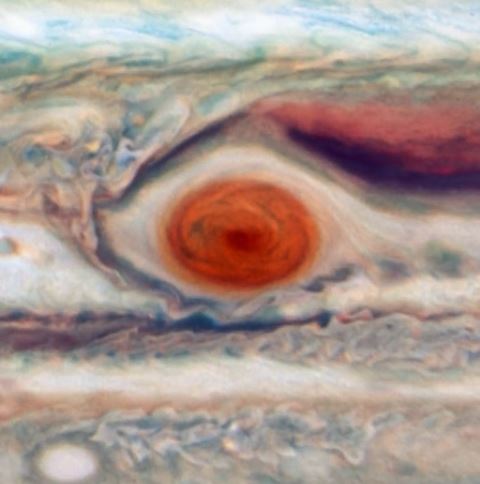Jupiter’s Great Red Spot is one of the solar system’s most awe-inspiring features. This enormous, elliptical storm with swirling hues of burnt orange and copper is a spectacle of planetary weather. Larger than Earth itself, the storm has winds that roar through Jupiter’s cloud tops at an astonishing 400 miles per hour.
From afar, the Great Red Spot may seem like a permanent fixture of the planet, but recent observations suggest otherwise. Scientists have discovered that the storm is not static; it is constantly changing, jiggling, and altering its shape as it journeys across Jupiter’s southern hemisphere. This shape-shifting behavior was revealed during a 90-day observation period, where the storm was found to stretch and contract as it circumnavigates the gas giant.
This unexpected discovery has left scientists baffled. “We were very surprised,” said Amy Simon, a planetary astronomer at NASA’s Goddard Space Flight Center and an author of a recent study published in The Planetary Science Journal. While it was long known that the Great Red Spot had been changing over the centuries, observing such rapid and distinct shape-shifting behavior over just a few months was shocking.
Though the spot’s movements might resemble a bouncing ball, some scientists liken it to a living creature. “The storm behaves like a slug, contracting and stretching as it moves around the planet,” said James O’Donoghue, a planetary astronomer at the University of Reading in England, who was not involved in the study. O’Donoghue jokingly referred to it as “The Great Red Slug.”
Whatever analogy one prefers, the underlying physics of this phenomenon remains a mystery. Scientists are still unsure why the storm behaves this way, and why it changes its form so dramatically.
The Great Red Spot has been observed continuously for the past 150 years, though it may not have always existed in its current form. Its exact origins remain unclear, and it’s possible that the storm will eventually disappear. The storm’s longevity is likely due to its position between two powerful jet streams that keep it in place. These streams prevent the storm from drifting toward the equator or the poles, where atmospheric forces could break it apart.
Despite its stable position, the storm is not completely stationary. It slowly drifts westward, taking several years to complete a full orbit around Jupiter. As it moves, it goes through a cycle of speeding up and slowing down every three months. This long-observed pattern has puzzled scientists for decades, as no one has been able to fully explain it.
To learn more about the Great Red Spot’s strange behavior, Dr. Simon and her team closely observed it between December 2023 and March 2024 using the Hubble Space Telescope. During this 90-day period, they were stunned to see the storm change size. When the storm moved at a slower pace, it stretched out and became more elongated; when it sped up, it compressed and became more compact.
Although the team could not explain why this shape-shifting occurred, they were aware that the Great Red Spot has undergone transformations before. In the late 1800s, the storm was more than three times the size of Earth, but it has been shrinking rapidly since then. This shrinking process may be the result of natural forces pushing the storm toward a more stable shape. Some scientists even speculate that the Great Red Spot may eventually disappear altogether.
The storm’s changing shape during the observation period was intriguing, but not entirely unexpected. “Such an elongated shape is not very stable,” Dr. Simon explained. The long-term changes to the storm’s size and shape may be part of its eventual dissolution, though when or how that might happen remains uncertain.
The study of Jupiter’s Great Red Spot is a reminder that even the most seemingly permanent features of our solar system are constantly in flux. The storm, like many natural phenomena, is a temporary and dynamic display of planetary beauty. Thanks to close-up observations from tools like the Hubble Space Telescope, we are fortunate to witness the ever-changing nature of this iconic storm in real time. The Great Red Spot, in all its shifting glory, offers scientists valuable insights into the complex and powerful weather systems of gas giants like Jupiter.

